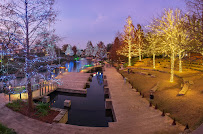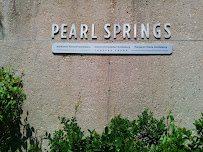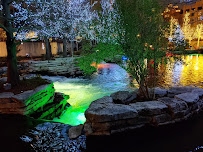





I’m sitting on the limestone steps of the Pearl Amphitheatre at 8:47 AM on a Saturday, watching the organized chaos of market setup unfold. A woman in a faded Spurs t-shirt is arguing with her husband about whether their tent is crooked. Three kids are chasing each other around the amphitheatre seats while their dad tries to balance a tower of folding chairs. Someone’s playing mariachi music from a bluetooth speaker, competing with the classic rock drifting over from the coffee truck.
This is what community looks like before the Instagram photos and the carefully curated experiences. It’s messy, loud, and absolutely perfect.
The Place That Almost Wasn’t
Let me tell you something about the Pearl District that most people don’t know: it almost became a strip mall. Back in 2001, when the Pearl Brewery shut down after 120 years of operation, developers were circling like vultures. The easy money was in tearing everything down and starting fresh—maybe a Target, some chain restaurants, the usual suburban sprawl that was eating Texas cities alive.
Thank God someone had better sense.
The brewery had been part of San Antonio’s DNA since 1881. My grandmother used to tell stories about her father working there during the Depression, how the smell of hops and grain would drift through the neighborhood on summer evenings. When I drive past the restored buildings now, I try to imagine what it was like when this place hummed with industrial life—the clank of machinery, the shouts of workers, the steady rhythm of production that kept families fed.
The amphitheatre sits right in the heart of what used to be the main production area. If you know where to look, you can still see the old railroad tracks embedded in the concrete, the loading dock doors that have been turned into windows, the brick walls that are thicker than most people’s entire apartments. The developers who took on this project didn’t just preserve these elements—they celebrated them.
Market Day Magic
By 9 AM, the Pearl Farmers Market is in full swing, and the amphitheatre becomes the unofficial town square of San Antonio. I’ve been coming here most Saturdays for the past three years, and I’m still discovering new vendors, new stories, new reasons to love this place.
There’s Carlos, who drives down from Fredericksburg every week with peaches so perfect they make you understand why people write poetry about fruit. He sets up his stand where he can hear the music from the amphitheatre stage, and he’ll tell you that the live performances help him sell more peaches. “People are happier when there’s music,” he says, handing me a sample that tastes like summer itself.
The amphitheatre’s design makes these kinds of interactions possible. It’s not so big that it feels impersonal, but it’s large enough to handle the crowds that show up every weekend. The acoustic properties are incredible—musicians can perform without overwhelming amplification, which means conversations can still happen, kids can still play, and the whole thing feels organic rather than orchestrated.
I watch families spread blankets on the grass in front of the stage, kids running between the market stalls and back to their parents, teenagers awkwardly flirting while pretending to be interested in artisanal soap. This is what urban planners call “programmed spontaneity”—creating spaces where unplanned interactions can happen naturally.
The River’s Influence
The San Antonio River runs right alongside the amphitheatre, and you can’t underestimate how much that water adds to the experience. There’s something about the sound of moving water that makes music sound better, food taste fresher, conversations flow more easily. On hot summer days, the river creates just enough of a breeze to make outdoor events bearable.
I’ve seen kids wade in the shallow parts during concerts, their parents watching nervously from the amphitheatre steps. I’ve watched couples walk hand-in-hand along the river path between market stalls, the water providing a soundtrack to their Saturday morning date. The river connects the Pearl to the broader San Antonio ecosystem in ways that wouldn’t be possible if this were just another indoor venue.
The Museum Reach section of the Riverwalk ends right here at Pearl, which means you can literally take a boat to the farmers market. I’ve never done it myself, but I love that the option exists. There’s something distinctly San Antonio about being able to arrive at a concert by river taxi.
Music in the Morning
The amphitheatre’s programming reflects the eclectic nature of San Antonio itself. On any given Saturday, you might hear a conjunto group followed by a singer-songwriter, followed by a jazz trio, followed by whatever local band happened to show up with their instruments. The booking isn’t always professional—sometimes it’s just whoever the market coordinator’s cousin knows—but that’s part of the charm.
Last month, I watched a twelve-year-old girl perform original songs she’d written about her cat. The month before, a group of mariachi musicians in their seventies played for tips while families ate breakfast tacos on the amphitheatre steps. Both performances were equally valid, equally worthy of attention, equally part of what makes this place special.
The acoustic design really shines during these morning performances. The limestone walls and curved seating create a natural amplification that makes even quiet singer-songwriters audible without drowning out the market activity. Musicians tell me they love performing here because they can actually hear themselves think, unlike some venues where the sound bounces around like a ping-pong ball.
The Food Connection
You can’t talk about the Pearl Amphitheatre without talking about food. The farmers market vendors represent everything that’s great about San Antonio’s food culture—family recipes passed down through generations, ingredients sourced from local farms, the kind of authenticity that chain restaurants spend millions trying to fake.
I have my regular vendors now. There’s the woman who makes tamales so good they should be illegal, the coffee roaster who knows exactly how I like my beans, the baker whose kolaches disappear by 10 AM every Saturday. These relationships developed gradually, naturally, the way friendships are supposed to form.
The amphitheatre provides the perfect backdrop for these food experiences. I’ve eaten more meals on these limestone steps than I care to count, watched more sunrises with a breakfast taco in one hand and coffee in the other, shared more conversations with strangers over shared appreciation for good food. The physical space encourages this kind of lingering, this kind of savoring.
Community in Action
What struck me most during the pandemic was how quickly the Pearl community adapted to keep the amphitheatre alive. When large gatherings were prohibited, they created socially distanced programming. When the farmers market had to reduce capacity, vendors worked together to make sure everyone could still participate. When musicians couldn’t perform for crowds, they livestreamed concerts from the empty amphitheatre.
The resilience came from the relationships that had developed over years of Saturday mornings. People didn’t just visit the Pearl—they belonged to it. The amphitheatre wasn’t just a venue—it was their venue, their community’s gathering place, worth fighting for when things got tough.
I remember one Saturday in late 2020, when we were all still figuring out how to be together safely. The usual crowd was smaller, everyone wearing masks, families staying within their designated spaces. But the music still played, the market still operated, and the river still flowed. The amphitheatre proved that community isn’t just about proximity—it’s about commitment.
The Economics of Authenticity
The Pearl’s success has surprised a lot of people in the development world. The conventional wisdom was that Americans wanted convenience and familiarity—chain stores, chain restaurants, plenty of parking. The Pearl proved that people were actually hungry for something more meaningful, even if it was less convenient.
The amphitheatre plays a crucial role in this economic model. It creates the kind of atmosphere that makes people want to linger, to explore, to spend money on experiences rather than just products. The farmers market alone brings thousands of people to the district every weekend, but many of them stay for lunch, or coffee, or just to walk around and soak up the atmosphere.
Local businesses have figured out how to work with the amphitheatre’s programming rather than against it. The coffee shops open early to catch the market crowd. The restaurants offer special brunch menus on performance days. The shops stay open later when evening concerts are scheduled. It’s the kind of symbiotic relationship that makes districts thrive.
Growing Pains
Success brings its own challenges. The Pearl is more crowded now than it was when I first started coming. Parking is harder to find. The farmers market vendors have waiting lists. Some of the original charm has been lost to popularity.
But the amphitheatre has adapted remarkably well to increased demand. The programming has become more sophisticated while maintaining its grassroots feel. The market has expanded to include more vendors while keeping its focus on local producers. The physical space has been improved without losing its essential character.
There are still problems. The success has pushed out some lower-income residents from the surrounding neighborhoods. Some vendors complain about rising fees. The balance between community space and commercial enterprise requires constant attention.
But these are good problems to have. They’re the problems that come with creating something people actually want to be part of.
The Next Generation
What gives me hope about the amphitheatre’s future is watching how kids interact with the space. They don’t see it as a historic preservation project or an urban planning success story. They see it as a playground, a place where interesting things happen, where they can run around while their parents shop for groceries.
I’ve watched children who could barely walk when I first started coming here grow into teenagers who now hang out at the amphitheatre with their friends. They’ve grown up thinking this is normal—that cities should have spaces where people gather, where music happens spontaneously, where food comes from actual farmers rather than industrial complexes.
These kids are going to have different expectations for their communities than previous generations. They’re going to demand authentic experiences, meaningful connections, spaces that serve multiple purposes. The amphitheatre is training them to expect better from their built environment.
Why It Works
The Pearl Amphitheatre succeeds because it does something that’s surprisingly rare in American urban development: it creates a space where different types of people can coexist comfortably. Families with young children share the space with teenagers, elderly couples, young professionals, tourists, locals who’ve been coming for years.
The secret is in the design and programming. The amphitheatre is formal enough to feel special but casual enough to feel welcoming. The music is sophisticated enough to attract serious listeners but accessible enough that kids can enjoy it. The food vendors are high-quality enough to satisfy foodies but affordable enough for families on a budget.
Most importantly, the space respects both its history and its present. The industrial past is celebrated rather than hidden, but it doesn’t overwhelm the contemporary uses. The result is a place that feels both timeless and of-the-moment, both rooted in San Antonio’s specific history and relevant to its current needs.
Saturday Afternoons
As I finish writing this, the morning market is winding down. The vendors are packing up their unsold produce, the musicians are unplugging their amplifiers, the families are shaking out their blankets and gathering their children. The amphitheatre is returning to its quiet state, the limestone steps empty except for a few people like me who aren’t ready to leave yet.
But I know that next Saturday, the whole cycle will begin again. The vendors will arrive in the pre-dawn darkness, the musicians will set up their equipment, the families will spread their blankets on the grass. The amphitheatre will once again become the heart of San Antonio’s most successful experiment in community building.
Some places are designed to be impressive. Others are designed to be functional. The Pearl Amphitheatre was designed to be both, but more importantly, it was designed to be loved. And after spending countless Saturday mornings here, watching the same faces week after week, seeing relationships form and deepen, witnessing the small miracles of community that happen when people are given a beautiful space to gather, I can tell you that it has succeeded beyond anyone’s wildest dreams.
The old brewery workers who once walked these floors would probably be amazed at what this place has become. But I think they’d also recognize something familiar in the energy, the sense of purpose, the feeling that important work is being done here. The product has changed from beer to community, but the commitment to craftsmanship, to quality, to serving something larger than yourself—that remains the same.
And every Saturday morning, as the sun rises over the San Antonio River and the first vendors begin setting up their stalls, the amphitheatre prepares to host another small miracle of human connection. Because that’s what great public spaces do—they don’t just accommodate community, they create it, one Saturday morning at a time.
